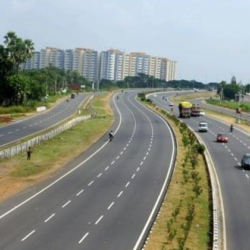The Debre Berhan Wind Power Project is a large-scale wind farm development designed to increase Ethiopia’s renewable energy generation. It is strategically located 27 km southwest of Debre Berhan city in the Semien Shewa Zone (Amhara Region) and North Shewa Zone (Oromia Region).
- Project Capacity: 126 MWac
- Land Area: 7,980 hectares
- Investment Type: Public-Private Partnership (PPP)
- Total Cost: $211.345 million
- Contracting Authority: Ethiopian Electric Power (EEP)
- Proposed Duration: 20-30 years
- Current Status: Feasibility study ongoing
- Region Covered: Amhara Regional State
The project site is well-positioned along Ethiopian Highway 2, which runs from Addis Ababa to Djibouti, making it a strategic location for energy distribution.
Key Stakeholders in the Project
The development of the wind farm involves multiple stakeholders:
- Ethiopian Electric Power (EEP): Responsible for project implementation and oversight
- Public-Private Partnership Directorate General: Managing the PPP process
- Private Investors: Expected to finance, construct, and operate the wind farm under a Build-Operate-Transfer (BOT) model
Project Scope and Objectives
The Debre Berhan Wind Power Project aims to:
✅ Increase Ethiopia’s renewable energy generation by 126 MW
✅ Enhance energy security and reduce dependence on fossil fuels
✅ Support industrial and economic growth by providing stable electricity supply
✅ Encourage private sector investment in Ethiopia’s energy infrastructure
✅ Expand clean energy availability to rural and urban communities
Financial Structure and Cost Estimation
The total estimated cost of the project is $211.345 million, structured as a PPP model, where private investors finance, build, and operate the wind farm.
| Project Component | Details |
|---|---|
| Wind Power Capacity | 126 MWac |
| Estimated Cost | $211.345 million |
| Investment Model | Build-Operate-Transfer (BOT) |
| Project Duration | 20-30 years |
| Revenue Source | Electricity sales & tariffs |
The BOT model allows private investors to recoup their investments through electricity tariffs before transferring the project back to the Ethiopian government.
Procurement Mode and PPP Structure
The Ethiopian government has chosen competitive bidding to select a private partner for the project. The Build-Operate-Transfer (BOT) model follows these steps:
🔹 Design: The private partner will develop the wind farm layout
🔹 Build: The investor will construct the wind farm and required transmission infrastructure
🔹 Finance: The project will be fully funded by private investment
🔹 Operate: The private investor will generate and supply electricity
🔹 Maintain: The wind farm will be maintained by the private operator
🔹 Transfer: After the concession period, ownership will be transferred to the government
Benefits of Public-Private Partnerships (PPPs) in Renewable Energy
PPPs play a crucial role in Ethiopia’s energy transition by offering:
✔️ Reduced financial burden on the government
✔️ Access to private sector expertise and innovation
✔️ Accelerated project implementation
✔️ Enhanced national power supply reliability
✔️ Long-term sustainability through private sector management
Challenges in PPP Implementation
Despite its benefits, PPP projects face several challenges:
⚠️ Regulatory and policy uncertainties
⚠️ Financial risks associated with power purchase agreements
⚠️ Technical integration challenges with Ethiopia’s power grid
⚠️ Potential land use conflicts and environmental concerns
Expected Impact on Ethiopia’s Energy Sector
⚡ Increased renewable energy contribution: The project will add 126 MW of wind power to Ethiopia’s electricity grid.
🌍 Reduced carbon emissions: A shift to wind energy will decrease Ethiopia’s reliance on fossil fuels.
📈 Enhanced energy security: More stable electricity supply will support industrial and economic growth.
Sustainability and Environmental Considerations
The Debre Berhan Wind Power Project will incorporate environmentally sustainable practices, including:
🌱 Use of renewable energy sources to minimize carbon footprint
🌍 Low environmental impact compared to fossil fuel power plants
🐦 Wildlife protection measures to reduce risks to bird migration patterns
Expected Timeline and Project Milestones
📅 Feasibility Study: Ongoing
📅 Bidding Process: Expected in the next phase
📅 Construction Start: Within 1-2 years
📅 Completion & Operation: Within 3-5 years
International Funding and Investment Opportunities
Ethiopia is actively seeking international investors and financial institutions to support its renewable energy sector. Potential funding sources include:
- African Development Bank (AfDB)
- World Bank
- Private equity infrastructure funds
- International renewable energy developers
Future Prospects for Renewable Energy Projects in Ethiopia
Ethiopia has significant potential for additional renewable energy projects, including:
✔️ Expansion of wind power capacity
✔️ Large-scale solar energy projects
✔️ Hydropower development
✔️ Geothermal energy initiatives
The Debre Berhan Wind Power Project is a strategic renewable energy initiative that aligns with Ethiopia’s commitment to clean energy development through Public-Private Partnerships (PPPs). By leveraging private sector investment, the project will enhance wind energy capacity, energy security, and economic development in the Amhara region and beyond.
With efficient execution, this project is expected to play a critical role in Ethiopia’s transition to a sustainable energy future, setting a benchmark for future renewable energy PPP projects in the country.

Frequently Asked Questions (FAQs)
❓ What is the purpose of the Debre Berhan Wind Power Project?
The project aims to generate 126 MWac of wind energy and enhance Ethiopia’s renewable energy capacity.
❓ How is the project funded?
It is financed through a Public-Private Partnership (PPP), where private investors will fund, build, and operate the wind farm.
❓ What is the PPP model used for this project?
The Build-Operate-Transfer (BOT) model, where the private investor operates the wind farm for 20-30 years before transferring it to the government.
❓ What is the estimated completion timeline?
The project is expected to be completed within 3-5 years after the bidding process.






